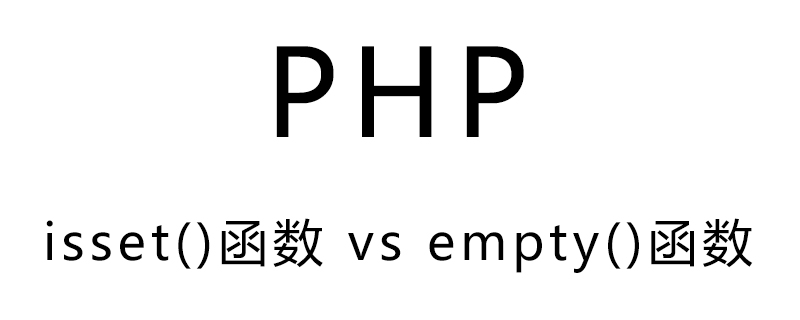 Backend Development
Backend Development
 PHP Tutorial
PHP Tutorial
 A brief discussion on the difference between isset() and empty() functions in PHP
A brief discussion on the difference between isset() and empty() functions in PHP
A brief discussion on the difference between isset() and empty() functions in PHP
It is easy to confuse between isset() and empty() in PHP. They are both used to test the value of variables and both return a Boolean value. The following article will take you to understand isset() and empty(), I hope it will be helpful to you.

PHP isset() function
isset() function is used to determine whether a variable has been set and is not null; in other words, returns true only if the variable is not null.
Basic sentence structure:
bool isset( mixed var [, mixed var [, ...]] )
Example:
<?php
header("content-type:text/html;charset=utf-8");
function checkIfIsset($value)
{
if(isset($value)) {
return "它被设定";
}else {
return "它没被设定";
}
}
$value = false;
echo checkIfIsset($value);
?>Output:

PHP empty() function
empty() function is used to determine whether a variable is empty; in other words, if the variable is an empty string, false, array(), NULL, "0 ”, 0 and unset variables, it will return true.
Basic sentence pattern:
bool empty(mixed var)
Example:
<?php
header("content-type:text/html;charset=utf-8");
function checkIfnotEmpty($value){
if (!empty($value)) {
return "它不是空的";
} else {
return "它是空的";
}
}
$value = '';
echo checkIfnotEmpty($value);
?>Output:

The difference between isset() and empty() functions in PHP
1. If the isset() function contains flase, 0 or empty string value, it will return true; otherwise it will return false. The empty() function returns true if it contains empty, 0, null or false values; if the string contains non-empty and non-zero values, it returns false.
2. If the value does not exist, the isset() function will return false, and the empty() function will return true.
The following table is a simple reference of what these functions will return for the different values. A space indicates that the function returns bool (false).
| Value of variable ($var) | isset($var) | empty($var) |
|---|---|---|
| ""(empty character String) | Boolean (true) | Boolean (true) |
| “ “ (space character) | Boolean (true) | |
| ##false | ## Boolean (true) | Boolean (true) |
| true | Boolean (true) | |
| Boolean (true) | Boolean (true) | |
|
Boolean (true) |
||
| Boolean (true) | Boolean (true) | |
| Boolean (true) | Boolean (true) | |
| Boolean (true) | Boolean (true) | |
| (Declared variable, but no Value) | ##Boolean (true) |
|
| NUllbyte("\0")Boolean (true) | The above is the entire content of this article, I hope it will be helpful to everyone's study. For more exciting content, you can pay attention to the relevant tutorial columns of the PHP Chinese website! ! ! |
The above is the detailed content of A brief discussion on the difference between isset() and empty() functions in PHP. For more information, please follow other related articles on the PHP Chinese website!

Hot AI Tools

Undresser.AI Undress
AI-powered app for creating realistic nude photos

AI Clothes Remover
Online AI tool for removing clothes from photos.

Undress AI Tool
Undress images for free

Clothoff.io
AI clothes remover

Video Face Swap
Swap faces in any video effortlessly with our completely free AI face swap tool!

Hot Article

Hot Tools

Notepad++7.3.1
Easy-to-use and free code editor

SublimeText3 Chinese version
Chinese version, very easy to use

Zend Studio 13.0.1
Powerful PHP integrated development environment

Dreamweaver CS6
Visual web development tools

SublimeText3 Mac version
God-level code editing software (SublimeText3)

Hot Topics
 1669
1669
 14
14
 1428
1428
 52
52
 1329
1329
 25
25
 1273
1273
 29
29
 1256
1256
 24
24
 PHP: A Key Language for Web Development
Apr 13, 2025 am 12:08 AM
PHP: A Key Language for Web Development
Apr 13, 2025 am 12:08 AM
PHP is a scripting language widely used on the server side, especially suitable for web development. 1.PHP can embed HTML, process HTTP requests and responses, and supports a variety of databases. 2.PHP is used to generate dynamic web content, process form data, access databases, etc., with strong community support and open source resources. 3. PHP is an interpreted language, and the execution process includes lexical analysis, grammatical analysis, compilation and execution. 4.PHP can be combined with MySQL for advanced applications such as user registration systems. 5. When debugging PHP, you can use functions such as error_reporting() and var_dump(). 6. Optimize PHP code to use caching mechanisms, optimize database queries and use built-in functions. 7
 PHP vs. Python: Understanding the Differences
Apr 11, 2025 am 12:15 AM
PHP vs. Python: Understanding the Differences
Apr 11, 2025 am 12:15 AM
PHP and Python each have their own advantages, and the choice should be based on project requirements. 1.PHP is suitable for web development, with simple syntax and high execution efficiency. 2. Python is suitable for data science and machine learning, with concise syntax and rich libraries.
 PHP and Python: Comparing Two Popular Programming Languages
Apr 14, 2025 am 12:13 AM
PHP and Python: Comparing Two Popular Programming Languages
Apr 14, 2025 am 12:13 AM
PHP and Python each have their own advantages, and choose according to project requirements. 1.PHP is suitable for web development, especially for rapid development and maintenance of websites. 2. Python is suitable for data science, machine learning and artificial intelligence, with concise syntax and suitable for beginners.
 PHP in Action: Real-World Examples and Applications
Apr 14, 2025 am 12:19 AM
PHP in Action: Real-World Examples and Applications
Apr 14, 2025 am 12:19 AM
PHP is widely used in e-commerce, content management systems and API development. 1) E-commerce: used for shopping cart function and payment processing. 2) Content management system: used for dynamic content generation and user management. 3) API development: used for RESTful API development and API security. Through performance optimization and best practices, the efficiency and maintainability of PHP applications are improved.
 The Enduring Relevance of PHP: Is It Still Alive?
Apr 14, 2025 am 12:12 AM
The Enduring Relevance of PHP: Is It Still Alive?
Apr 14, 2025 am 12:12 AM
PHP is still dynamic and still occupies an important position in the field of modern programming. 1) PHP's simplicity and powerful community support make it widely used in web development; 2) Its flexibility and stability make it outstanding in handling web forms, database operations and file processing; 3) PHP is constantly evolving and optimizing, suitable for beginners and experienced developers.
 PHP and Python: Different Paradigms Explained
Apr 18, 2025 am 12:26 AM
PHP and Python: Different Paradigms Explained
Apr 18, 2025 am 12:26 AM
PHP is mainly procedural programming, but also supports object-oriented programming (OOP); Python supports a variety of paradigms, including OOP, functional and procedural programming. PHP is suitable for web development, and Python is suitable for a variety of applications such as data analysis and machine learning.
 PHP vs. Other Languages: A Comparison
Apr 13, 2025 am 12:19 AM
PHP vs. Other Languages: A Comparison
Apr 13, 2025 am 12:19 AM
PHP is suitable for web development, especially in rapid development and processing dynamic content, but is not good at data science and enterprise-level applications. Compared with Python, PHP has more advantages in web development, but is not as good as Python in the field of data science; compared with Java, PHP performs worse in enterprise-level applications, but is more flexible in web development; compared with JavaScript, PHP is more concise in back-end development, but is not as good as JavaScript in front-end development.
 PHP and Python: Code Examples and Comparison
Apr 15, 2025 am 12:07 AM
PHP and Python: Code Examples and Comparison
Apr 15, 2025 am 12:07 AM
PHP and Python have their own advantages and disadvantages, and the choice depends on project needs and personal preferences. 1.PHP is suitable for rapid development and maintenance of large-scale web applications. 2. Python dominates the field of data science and machine learning.



